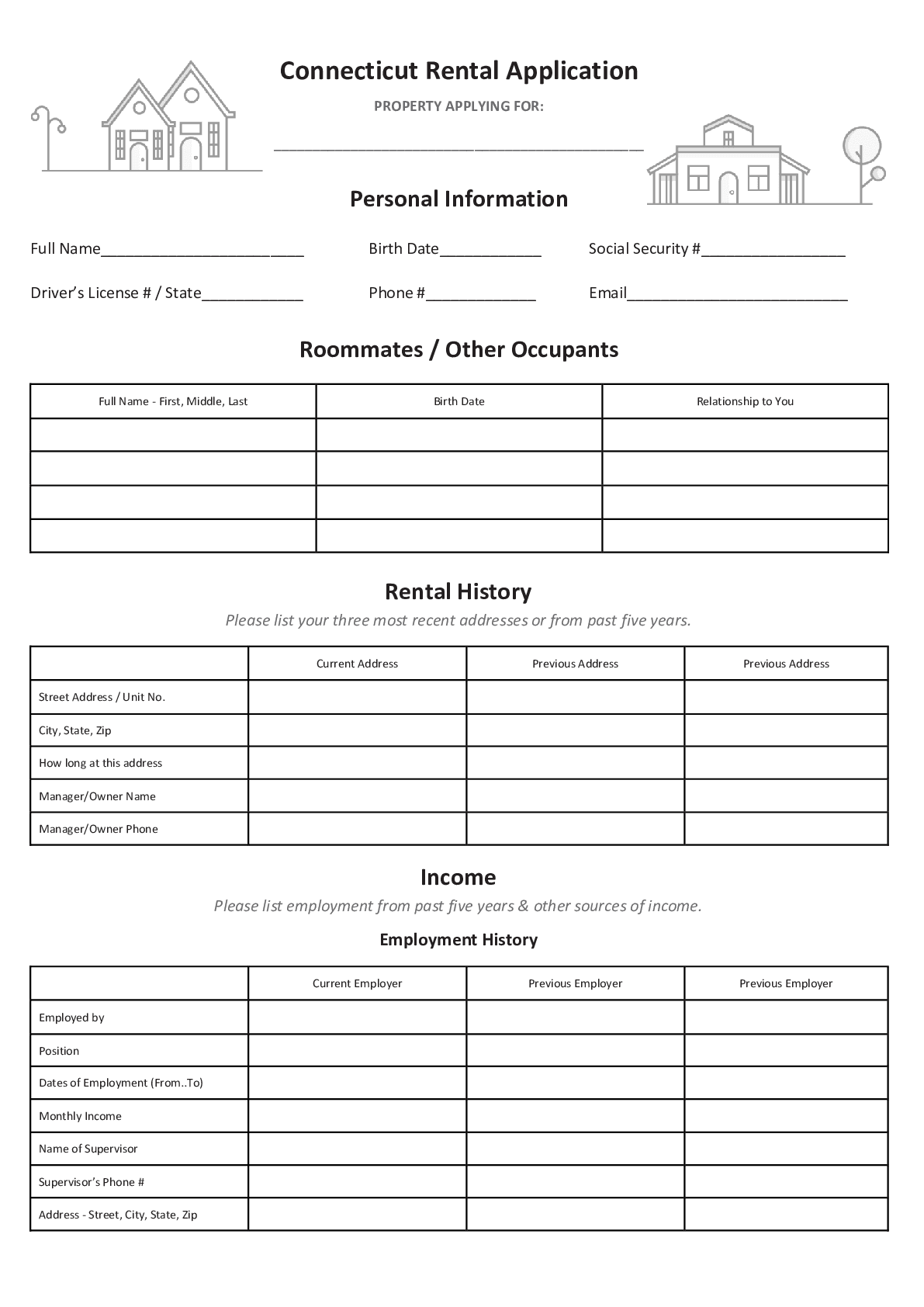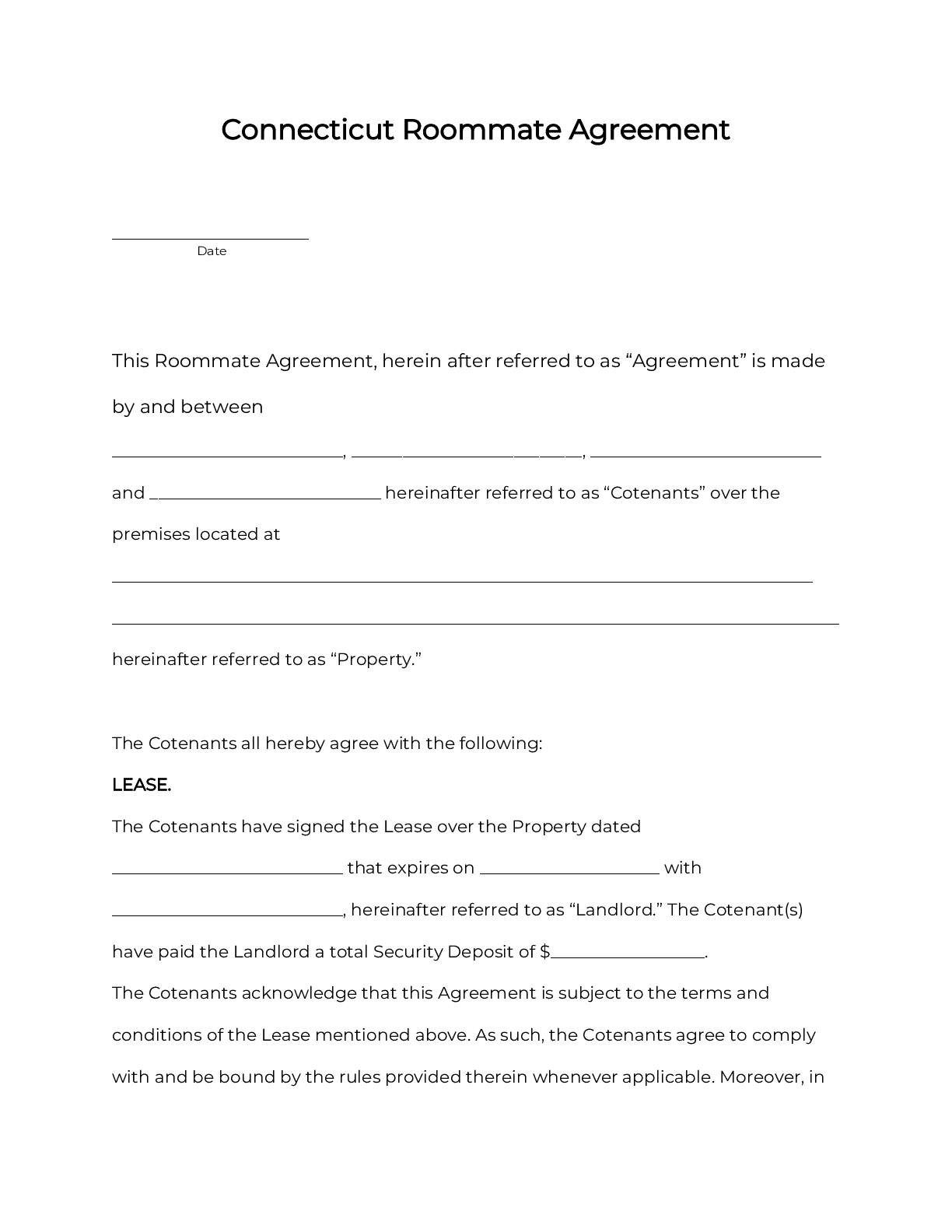 Lease Agreement Template_1 on iPropertyManagement.com" width="1224" height="1584" />
Lease Agreement Template_1 on iPropertyManagement.com" width="1224" height="1584" />  Lease Agreement Template_1 on iPropertyManagement.com" width="1224" height="1584" />
Lease Agreement Template_1 on iPropertyManagement.com" width="1224" height="1584" />
A Connecticut rental agreement is a legal contract between a landlord overseeing a rental property and a tenant who wishes to use it. Connecticut landlord-tenant law governs these agreements; rental terms must be within the limits allowed by law.

A Connecticut residential lease agreement (“rental agreement”) is a legal contract for a tenant to rent a residential property from a landlord, subject to terms and conditions agreed by all parties.

A Connecticut month-to-month lease agreement is a contract (not necessarily written) where a tenant rents property from a landlord. The full rental term is one month, renewable on a month-to-month basis.

Connecticut landlords may use a rental application form to screen prospective tenants. A rental application collects information relating to finances, rental history, and past evictions.

A Connecticut sublease agreement is a legal contract where a tenant ("sublessor") rents (“subleases”) property to a new tenant (“sublessee”), usually with the landlord’s permission.

A Connecticut roommate agreement is a legal contract between two or more people (“co-tenants”) who share a rental property according to rules they set, including for things like splitting the rent. This agreement binds the co-tenants living together, and doesn’t include the landlord.

A Connecticut commercial lease agreement is a legal contract arranging the rental of commercial space between a landlord and a business.
To learn more about required disclosures in Connecticut, click here.
To learn more about landlord tenant laws in Connecticut, click here.
(a) As used in this section, “walk-through” means a joint physical inspection of the dwelling unit by the landlord and the tenant, or their designees, for the purpose of noting and listing any observed conditions within the dwelling unit. On and after January 1, 2024, upon or after the entry into a rental agreement but prior to the tenant’s occupancy of a dwelling unit, a landlord shall offer such tenant the opportunity to conduct a walk-through of the dwelling unit. If the tenant requests such a walk-through, the landlord and tenant, or their designees, shall use a copy of the preoccupancy walk-through checklist prepared by the Commissioner of Housing under subsection (c) of this section. The landlord and the tenant, or their designees, shall specifically note on the walk-through checklist any existing conditions, defects or damages to the dwelling unit present at the time of the walk-through. After the walk-through, the landlord and the tenant, or their designees, shall sign duplicate copies of the walkthrough checklist and each shall receive a copy. (b) Upon the tenant’s vacating of the dwelling unit, the landlord may not retain any part of the security deposit collected under chapter 831 of the general statutes or seek payment from the tenant for any condition, defect or damage that was noted in the preoccupancy walk-through checklist. Such walk-through checklist shall be admissible, subject to the rules of evidence, but shall not be conclusive, as evidence of the condition of the dwelling unit at the beginning of a tenant’s occupancy in any administrative or judicial proceeding. (c) Not later than December 1, 2023, the Commissioner of Housing shall (1) prepare a standardized preoccupancy walk-through checklist for any landlord and tenant to use to document the condition of any dwelling unit during a preoccupancy walk-through under subsection (a) of this section, and (2) make such checklist available on the Department of Housing’s Internet web site. (d) The provisions of this section shall not apply to any tenancy under a rental agreement entered into prior to January 1, 2024.
(1) On and after January 1, 2024, whenever a dwelling unit located in a building or complex consisting of five or more separate dwelling units or in a mobile manufactured home park is rented to, or a rental agreement is entered into or renewed with, a tenant, the landlord of such dwelling unit or such landlord’s agent shall provide such tenant with written notice of the provisions of subsections (b) and (c) of this section in a form as described in subdivision (2) of this subsection. (2) Not later than December 1, 2023, the Commissioner of Housing shall create a notice to be used by landlords, pursuant to subdivision (1) of this subsection, to inform tenants of the rights provided to protected tenants under subsections (b) and (c) of this section. Such notice shall be a one-page, plain-language summary of such rights and shall be available in both English and Spanish. Not later than December 1, 2023, such notice shall be posted on the Department of Housing’s Internet web site. (3) Not later than December 1, 2028, the commissioner shall (A) translate the notice required under subdivision (2) of this subsection into the five most commonly spoken languages in the state, as determined by the commissioner, and (B) post such translations on the Department of Housing’s Internet web site not later than December 1, 2028.
(a)(1) Except as provided in subdivision (2) of this subsection, this section applies to any tenant who resides in a building or complex consisting of five or more separate dwelling units or who resides in a mobile manufactured home park and who is either:
(A) Sixty-two years of age or older, or whose spouse, sibling, parent or grandparent is sixty-two years of age or older and permanently resides with that tenant, or
(B) a person with a physical or mental disability, as defined in subdivision (8) of section 46a-64b, or whose spouse, sibling, child, parent or grandparent is a person with a physical or mental disability who permanently resides with that tenant, but only if such disability can be expected to result in death or to last for a continuous period of at least twelve months.
(b) (1) No landlord may bring an action of summary process or other action to dispossess a tenant described in subsection (a) of this section except for one or more of the following reasons:
(A) Nonpayment of rent;
(B) refusal to agree to a fair and equitable rent increase, as defined in subsection (c) of this section;
(C) material noncompliance with section 47a-11 or subsection (b) of section 21-82, which materially affects the health and safety of the other tenants or which materially affects the physical condition of the premises;
(D) voiding of the rental agreement pursuant to section 47a-31, or material noncompliance with the rental agreement;
(E) material noncompliance with the rules and regulations of the landlord adopted in accordance with section 47a-9 or 21-70;
(F) permanent removal by the landlord of the dwelling unit of such tenant from the housing market; or
(G) bona fide intention by the landlord to use such dwelling unit as his principal residence.
(2) Upon termination of a tenancy, any tenant may notify the landlord in writing of such tenant’s forwarding address. Not later than twenty-one days after termination of a tenancy or fifteen days after receiving written notification of such tenant’s forwarding address, whichever is later, each landlord other than a rent receiver shall deliver to the tenant or former tenant at such forwarding address either (A) the full amount of the security deposit paid by such tenant plus accrued interest, or (B) the balance of such security deposit and accrued interest after deduction for any damages suffered by such landlord by reason of such tenant’s failure to comply with such tenant’s obligations, together with a written statement itemizing the nature and amount of such damages. Any landlord who violates any provision of this subsection shall be liable for twice the amount of any security deposit paid by such tenant, except that, if the only violation is the failure to deliver the accrued interest, such landlord shall be liable for ten dollars or twice the amount of the accrued interest, whichever is greater.
If a rental agreement contains a valid written agreement to pay a late charge in accordance with subsection (a) of section 47a-4 , a landlord may assess a tenant such a late charge on a rent payment made subsequent to the grace period in accordance with this section. Such late charge may not exceed the lesser of (1) five dollars per day, up to a maximum of fifty dollars, or (2) five per cent of the delinquent rent payment or, in the case of a rental agreement paid in whole or in part by a governmental or charitable entity, five per cent of the tenant’s share of the delinquent rent payment. The landlord may not assess more than one late charge upon a delinquent rent payment, regardless of how long the rent remains unpaid.
“This matter is dismissed as a 30-day notice under the Cares Act was not provided to the tenant.”